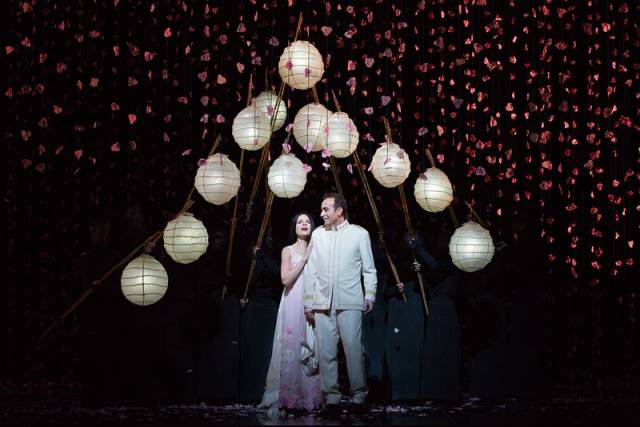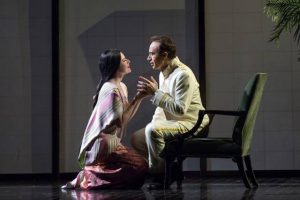

Director Anthony Minghella’s sumptuous and visually stunning production of Madama Butterfly is matched perfectly to the sweeping lush melodies of Giacomo Puccini. Lovingly directed and choreographed by Carolyn Choa, Mr. Minghella’s widow (Mr. Minghella passed away in 2008), this production premiered at the Met ten years ago and is part of the Metropolitan Opera’s 2015-2016 season. Working with a brilliant team, set designer Michael Levine, lighting designer Peter Mumford and the exquisite artistry of costume designer Han Feng plus the bunraku puppets of Blind Summit Theatre, Mr. Minghella surrounds us with a grand yet delicate mixture of beauty and sorrow, propelling us back in time to when the Far East was the exotic Orient to the Western world. The diverse Met audience, old and young, wealthy and struggling, New Yorkers and tourists, sat enrapt from the silent opening geisha fan dance to the last unresolved chord; the curtain falling on a stage bathed in red silk.
Puccini’s Madama Butterfly has been one of the world’s most popular operas for over a century. Based on the great American theater impresario David Belasco’s play Madame Butterfly, the sad story takes place in Nagasaki, Japan around 1900 as trade between the East and the West is opening up. Cio-Cio San, a 15-year-old geisha girl, is being “married” for 100 yen to an American navel Lieutenant, Benjamin Franklin Pinkerton. Calling himself a "Yankee vagabond" interested in exploring the pleasures of the world, "boldly casting at random his anchor / winning the best and fairest of each country," Pinkerton proclaims that when he does have a real marriage and takes a real wife, she will be American. Against the backdrop of clashing cultures, a score filled with romantic melodies coupled with Asian tonalities and national anthems (the Star-Spangled Banner is heard several times), a one-sided love story unfolds to a tragic end.
Conductor Karel Mark Chichon, in his Met debut, guides the phrasing of both orchestra and chorus with an expansive ebb and flow. American spinto soprano Ana María Martínez dazzles in the demanding role of Cio-Cio San, filling each moment with emotional depth. Her silvery soprano spins pianissimo high notes effortlessly, along with a rich lower register; she reveals the innocence, fears and steel spine of a girl who renounces her religion, becoming a Christian to unite with her American husband, and who is abandoned by her relatives and ultimately Pinkerton. In the famous aria Un bel di vedremo, Ms. Martínez not only sings with expressive beauty, but layers in the ache of loneliness; she is both ravishing and devastating in the final scene. As the servant Suzuki, Maria Zifchak is superb, creating a compassionate character with her vivid mezzo soprano.

Also making his Met debut, the gifted baritone Artur Ruciński won over the audience with his empathetic portrayal of Sharpless, the U.S. Consul. Totally believable and bringing integrity to the role, Mr. Ruciński is a wonderful actor with a naturalistic presence on stage. Roberto De Biasio, in a nuanced performance as Pinkerton, possesses a soaring tenor voice, capturing the cavalier cad who knows no consequences to his actions. Standouts in smaller roles include Tyler Duncan as the infatuated suitor Yamadori and Tony Stevenson, playing the marriage broker Goro with used car salesman oiliness.
Mr. Minghella’s attention to detail is sublime. His cinematic genius is felt from Butterfly’s first entrance with her many relatives, bedecked in jewel tones and intricate patterns, fans flashing as they appear over the hill, to their exit shaming Butterfly for her conversion, clucking "We all renounce you! Hou! Cho-cho-san!" In another moment, the long duet that closes Act I, lantern bob in different configurations in the garden (operated by a magnificent ensemble of bunraku puppeteers) as Pinkerton leads Butterfly to the marriage bed; what could have been a staid scene becomes a fluid seduction filled with metaphor.
Mr. Minghella also pays attention to emotional details, giving precise stylized movement to dramatic moments that make the audience gasp or shudder. In one such moment, Pinkerton’s touches of brutality are hidden beneath his desire as he answers Butterfly’s query about the practice of pinning a butterfly’s wings and leaving it to die. "That you may not escape/See, I have caught you," he sings as he grips her outstretched arms. A bunraku puppet is used for Butterfly’s little boy, another stylized choice that reverberates with this story in a way not possible if the role had been played by a child. Puppeteers Kevin Augustine, Tom Lee and Marc Petrosino are the creators of this heartbreaking little character. In experiencing this glorious production of Madama Butterfly, it is impossible not to wonder what kind of magic the late Mr. Minghella might have done with the next opera on his list.
Performances of Madama Butterfly continue at the Metropolitan Opera through April 12.